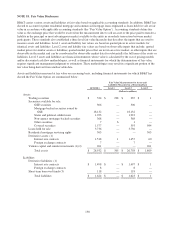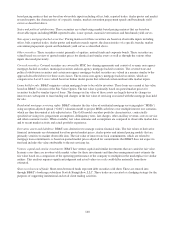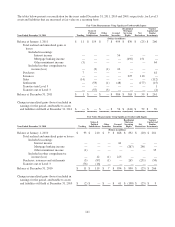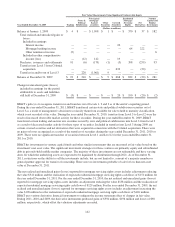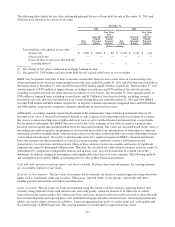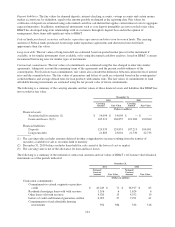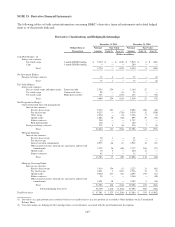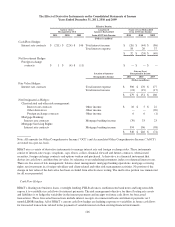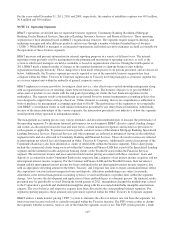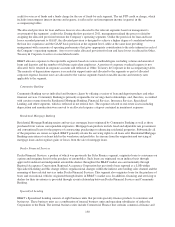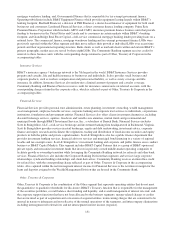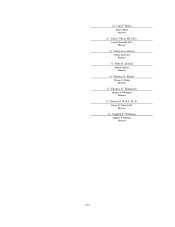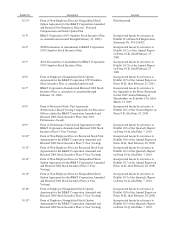BB&T 2011 Annual Report Download - page 147
Download and view the complete annual report
Please find page 147 of the 2011 BB&T annual report below. You can navigate through the pages in the report by either clicking on the pages listed below, or by using the keyword search tool below to find specific information within the annual report.For a qualifying cash flow hedge, the portion of changes in the fair value of the derivatives that has been highly effective is
recognized in other comprehensive income (loss) until the related cash flows from the hedged item are recognized in earnings. If
a derivative designated as a cash flow hedge is terminated or ceases to be highly effective, the gain or loss in other
comprehensive income (loss) is amortized to earnings over the period the forecasted hedged transactions impact earnings. If a
hedged forecasted transaction is no longer probable of occurring during the forecast period or within a short period thereafter,
hedge accounting is ceased and any gain or loss included in other comprehensive income (loss) is reported in earnings
immediately. During the years ended December 31, 2011 and 2010, BB&T amortized approximately ($32) million and $24
million of unrecognized pre-tax gains (losses) from accumulated other comprehensive income (loss) into net interest income.
At December 31, 2011, BB&T had $254 million of unrecognized pre-tax losses on derivatives classified as cash flow
hedges recorded in other comprehensive income (loss), compared to $75 million of unrecognized pre-tax losses at
December 31, 2010. The estimated amount to be reclassified from other comprehensive income (loss) into earnings during
the next 12 months is a loss totaling approximately $39 million. This includes active hedges and gains and losses related
to hedges that were terminated early for which the forecasted transactions are still probable. The proceeds from these
terminations were included in cash flows from financing activities.
All cash flow hedges were highly effective for the twelve months ended December 31, 2011, and the change in fair value
attributed to hedge ineffectiveness was not material.
Fair Value Hedges
BB&T’s fixed rate long-term debt, certificates of deposit, FHLB advances, loan and state and political subdivision
security assets result in exposure to losses in value as interest rates change. The risk management objective for hedging
fixed rate assets and liabilities is to convert the fixed rate paid or received to a floating rate. BB&T accomplishes its risk
management objective by hedging exposure to changes in fair value of fixed rate financial instruments primarily through
the use of swaps. For a qualifying fair value hedge, changes in the value of the derivatives that have been highly effective
as hedges are recognized in current period earnings along with the corresponding changes in the fair value of the
designated hedged item attributable to the risk being hedged.
During years ended December 31, 2011 and 2010, BB&T terminated certain fair value hedges primarily related to its long-
term debt and received proceeds of $185 million and $314 million, respectively. When hedged debt/other financial
instruments are retired or redeemed, the amounts associated with the hedge are included as a component of the gain or loss
on termination. When a hedge is terminated but the hedged item remains outstanding, the proceeds from the termination of
these hedges have been reflected as part of the carrying value of the underlying debt/other financial instrument and are being
amortized to earnings over its estimated remaining life. The proceeds from these terminations were included in cash flows
from financing activities. During the years ended December 31, 2011 and 2010, BB&T recognized pre-tax benefits of $205
million and $71 million respectively through reductions of interest expense from previously unwound fair value hedges.
Derivatives Not Designated As Hedges
Derivatives not designated as a hedge include those that are entered into as either balance sheet risk management
instruments or to facilitate client needs. Balance sheet risk management hedges are those hedges that do not qualify to be
treated as a cash flow hedge, a fair value hedge or a foreign currency hedge for accounting purposes, but are necessary to
economically manage the risk associated with an asset or liability.
This category of hedges includes derivatives that hedge mortgage banking operations and MSRs. For mortgage loans
originated for sale, BB&T is exposed to changes in market rates and conditions subsequent to the interest rate lock and
funding date. BB&T’s risk management strategy related to its interest rate lock commitment derivatives and loans held for
sale includes using mortgage-based derivatives such as forward commitments and options in order to mitigate market risk.
For MSRs, BB&T uses various derivative instruments to mitigate the income statement effect of changes in the fair value
of its MSRs. For the year ended December 31, 2011, BB&T recorded a gain totaling $394 million related to these
derivatives which was offset by a decrease in the carrying value of mortgage servicing assets totaling $341 million. For
the year ended December 31, 2010, BB&T recognized a $196 million gain on these derivatives, which was offset by a
negative $138 million valuation adjustment related to the mortgage servicing asset.
BB&T also held, as risk management instruments, other derivatives not designated as hedges primarily to facilitate
transactions on behalf of its clients, as well as activities related to balance sheet management.
147



